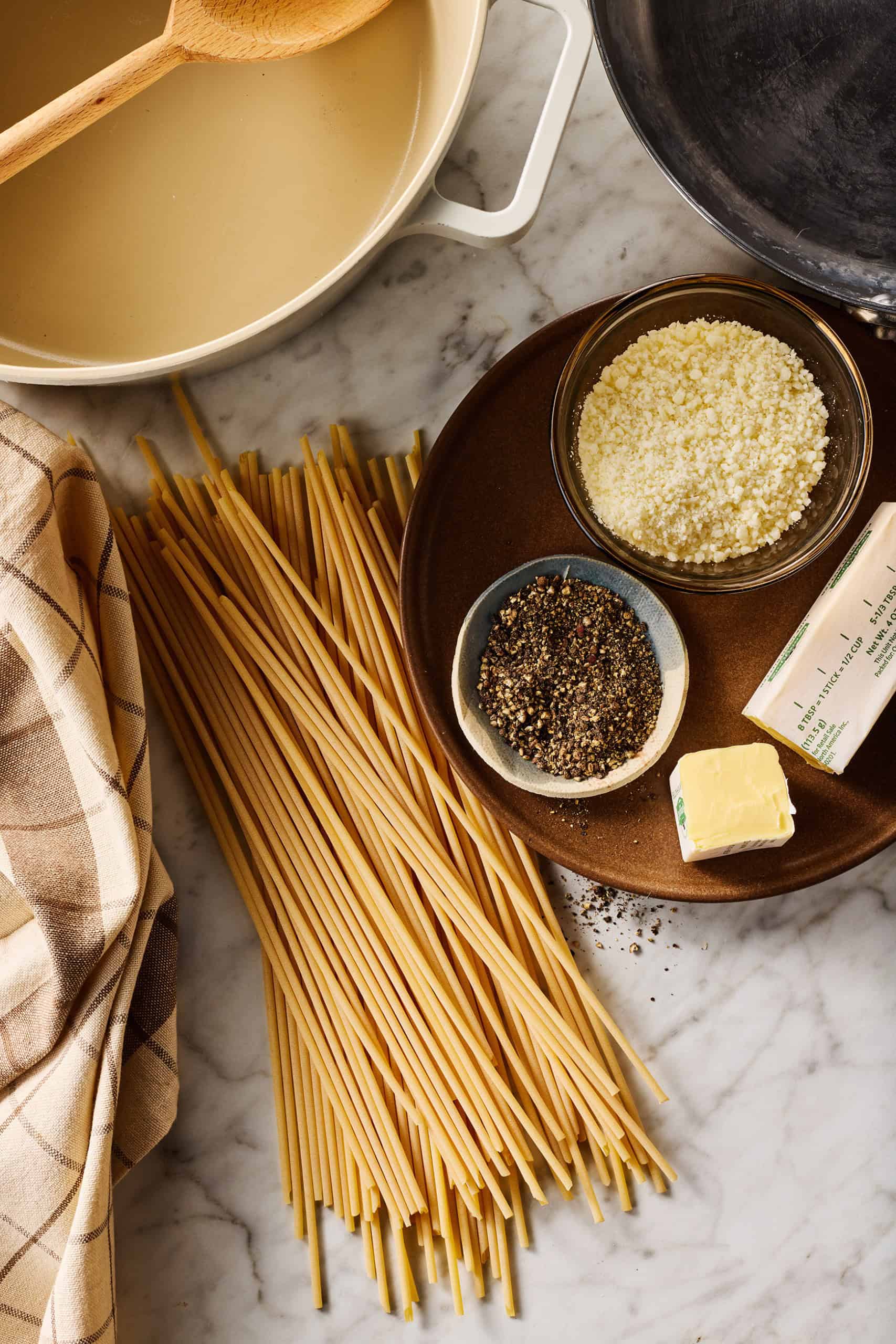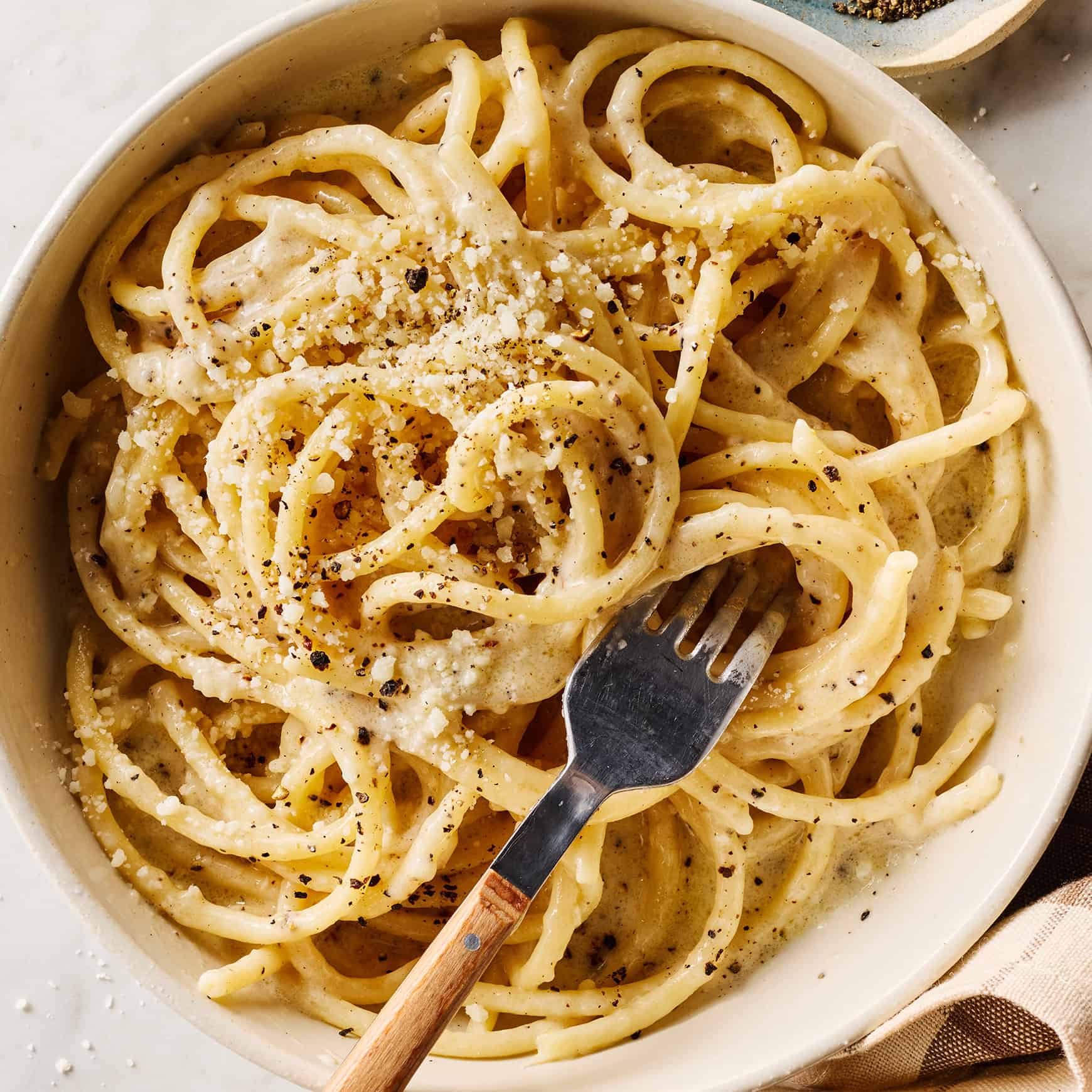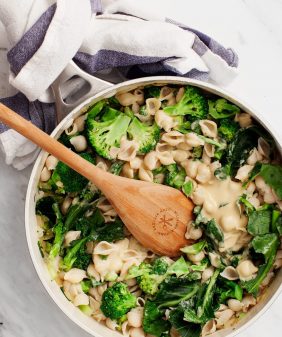Cacio e pepe is a classic Roman pasta with a glossy sauce made of pecorino cheese and black pepper. Learn how to make it with this simple recipe!

Cacio e pepe is like mac and cheese’s cool Italian cousin. It’s creamy and comforting, sure, but it’s also simple and elegant. Traditionally, this Roman dish consists of three ingredients: Pecorino Romano cheese, freshly cracked black pepper, and pasta. A little pasta water helps the cheese and pepper come together to form the pasta’s silky sauce.
I’ve been a fan of cacio e pepe since I first tasted it on a trip to Rome years ago. I love the salty funk of the cheese against the bite of the black pepper. I’ve made it at home many times…with mixed success. Despite its simplicity, cacio e pepe is famously tricky to make, and I’ve had my fair share of failed attempts (think cheese clumps).
But after a lot of trial and error, I’ve finally mastered my technique. Made with one extra ingredient, this cacio e pepe recipe is easier than an entirely authentic one, and it tastes just as delicious. Try it on a weeknight or a date night—it’d be perfect for either.
What is cacio e pepe?
Cacio e pepe is a classic Roman pasta dish. Its name translates to “cheese and pepper,” referring to its two star ingredients: Pecorino Romano and black pepper.
They—along with a little pasta cooking water—create a lightly creamy, glossy pasta sauce. The sauce is traditionally tossed with a long pasta shape such as tonnarelli, bucatini, or spaghetti.

Cacio e Pepe Ingredients
Here’s what you’ll need to make this cacio e pepe recipe:
- Pasta, of course! A long pasta shape is traditional. Bucatini is my #1 pick for this recipe, but spaghetti or linguine works too.
- Cheese – Pecorino Romano is an aged sheep’s cheese. It gives this pasta its creamy texture and distinctive salty funk. For a fun variation, use a 50/50 mix of grated pecorino and Parmesan.
- Black pepper – Not the kind from a shaker! For the punchiest flavor, grind the pepper yourself just before making this dish.
- And unsalted butter – My secret ingredient. The biggest challenge of making cacio e pepe is getting the cheese to melt down into a smooth sauce. For most home cooks (myself included), this can be tricky to achieve using only cheese and pasta water. The butter makes this recipe a bit more foolproof. Don’t skip it!
Find the complete recipe with measurements below.

How to Make Cacio e Pepe
You can find the complete recipe with measurements at the bottom of this post. For now, here’s a quick overview of how it goes:
- First, cook the pasta in a large pot of salted boiling water.
- Meanwhile, heat the butter and pepper in a large skillet over medium heat. Cook until the butter is melted, about 30 seconds. Remove from the heat.
- Next, add the pasta to the skillet with the butter. When the pasta is al dente, scoop it directly out of the pasta pot and into the skillet. (A spider or tongs work well for this.)
- Make the sauce by gradually adding some of the starchy pasta water and the cheese to the skillet. Toss until the cheese forms a glossy sauce that lightly coats the pasta, adding more pasta water as needed.
- Serve topped with more black pepper and cheese. Yum!
Recipe Tips
- Grate the cheese yourself. I’ve given this tip before in my recipes for mac and cheese and broccoli cheddar soup. Anytime you want cheese to melt down into a creamy sauce, it’s best to grate it yourself. Pre-grated cheese typically contains anti-caking agents that can prevent the cheese from forming a cohesive sauce.
- Grate it finely. Finely grating the cheese helps it melt quickly and evenly, making it less likely to clump. I recommend using a microplane zester!
- Don’t drain the pasta. Scooping the pasta directly out of the pot means that 1) it’ll be hot when you add it to the skillet and 2) it’ll bring some starchy pasta water with it. Both of these things will help you create a smooth sauce. Bonus: You’ll have a whole pot of pasta water handy, so you can use more as needed.
- Serve it right away. This cacio e pepe recipe is best hot off the stove. Enjoy it with a big green salad or roasted broccoli for a simple, delicious meal.

More Pasta Recipes to Try
If you love this cacio e pepe recipe, try one of these simple pastas next:

Cacio e Pepe
Ingredients
- 8 ounces bucatini pasta
- 2 tablespoons unsalted butter
- 1 teaspoon freshly ground coarse black pepper, plus more for serving
- 2 ounces finely grated Pecorino Romano cheese, about 1 cup, plus more for serving
Instructions
- Bring a large pot of salted water to a boil. Prepare the pasta according to the package instructions, cooking until al dente.
- Meanwhile, heat a large skillet (a 10-inch nonstick pan works well) over medium heat. Add the butter and pepper and cook for 30 seconds, or until the butter is melted. Remove the pan from the heat.
- When the pasta is just al dente, use tongs to transfer it directly from the pot to the skillet with the butter mixture. Add ⅓ cup pasta water and toss to combine. Add half the cheese and toss to coat. Add the remaining cheese and continue tossing until the cheese forms a glossy sauce that lightly coats the pasta. If needed, add a few more tablespoons of pasta water as you toss to help the cheese melt into a smooth, creamy sauce.
- Serve immediately, topped with more freshly ground black pepper and cheese.














Husband loved it. SO quick and easy.
Will use often.
A wonderful reminder for me, love this dish but usually default to making Carbonara instead, so thank you for this!